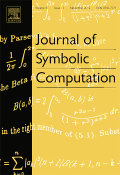
JOURNAL OF SYMBOLIC COMPUTATION
Scope & Guideline
Advancing the Frontiers of Mathematical Insight
Introduction
Aims and Scopes
- Symbolic Computing Algorithms:
The journal emphasizes the development and analysis of algorithms that manipulate mathematical expressions symbolically rather than numerically, enabling exact computations. - Algebraic Structures and Computation:
Research on algebraic structures, such as rings, fields, and modules, is a core focus, exploring how these can be effectively manipulated and utilized in computations. - Applications of Symbolic Computation:
The journal highlights applications of symbolic computation in various domains, including algebraic geometry, combinatorics, and optimization, showcasing its practical relevance. - Interdisciplinary Approaches:
Papers often bridge symbolic computation with other areas such as machine learning, cryptography, and computational biology, reflecting the journal's commitment to interdisciplinary research. - Theoretical Foundations:
Theoretical contributions that enhance the understanding of symbolic computation, including complexity analysis and formal verification techniques, are also a significant aspect of the journal.
Trending and Emerging
- Machine Learning Integration:
There is a growing trend of integrating machine learning methods with symbolic computation, focusing on applications that enhance algorithmic efficiency and predictive capabilities. - Advanced Algebraic Geometry:
Research in advanced algebraic geometry, particularly involving computational techniques and symbolic methods, has gained traction, reflecting the increasing complexity of problems being addressed. - Quantum Computing Approaches:
Emerging studies are exploring the intersection of symbolic computation and quantum computing, indicating a significant interest in developing algorithms suitable for quantum environments. - Optimization and Decision-Making:
There is an increasing focus on optimization problems and decision-making processes, with symbolic computation being applied to derive efficient solutions in various contexts. - Symbolic Dynamics and Complexity:
The exploration of symbolic dynamics and its complexity aspects is gaining attention, reflecting a broader interest in understanding the computational limits and capabilities of symbolic systems.
Declining or Waning
- Purely Numerical Methods:
There has been a noticeable decrease in publications focused solely on numerical methods, as the journal increasingly prioritizes symbolic and algebraic approaches. - Basic Polynomial Algebra:
Research on elementary polynomial algebra techniques appears to be waning, possibly due to the maturation of these topics and a shift towards more complex applications and theories. - Classical Computational Geometry:
While still relevant, classical computational geometry topics have seen fewer submissions, as researchers explore more advanced geometrical methods and applications in symbolic computation. - Non-symbolic Algorithm Comparisons:
Papers that primarily compare symbolic and non-symbolic algorithms without offering new insights or methodologies have become less frequent, indicating a shift towards more innovative contributions.
Similar Journals
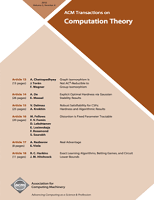
ACM Transactions on Computation Theory
Advancing the Boundaries of Computation Theory.ACM Transactions on Computation Theory, published by the Association for Computing Machinery, is a prestigious journal dedicated to advancing the field of computation theory and theoretical computer science. With an ISSN of 1942-3454 and an E-ISSN of 1942-3462, this journal serves as a vital resource for researchers and professionals seeking to explore groundbreaking developments in computational models, algorithms, and their mathematical foundations. The journal's rigorous standards have earned it a significant position within the academic community, as evidenced by its 2023 category quartiles, ranking in the Q1 category for Computational Theory and Mathematics and Q2 for Theoretical Computer Science. Although it operates through traditional subscription access, it maintains a critical role in disseminating cutting-edge research and fostering collaboration among experts in the United States and beyond. As an influential platform, ACM Transactions on Computation Theory is committed to contributing to the ongoing dialogue and advancement of computation theory, making it essential reading for anyone passionate about this dynamic field.

Computation
Transforming challenges into solutions through computation.Computation, published by MDPI, is an esteemed open-access journal that has been contributing to the fields of applied mathematics and computer science since its inception in 2013. With an E-ISSN of 2079-3197, this Swiss-based journal operates under a philosophy of free knowledge dissemination, allowing researchers, professionals, and students globally to access high-quality content without financial barriers. Recognized for its rigorous peer-review process, Computation is currently categorized in the Q2 and Q3 quartiles across significant domains, including Applied Mathematics (#181/635), Theoretical Computer Science (#52/130), and Modeling and Simulation (#138/324). As it converges towards 2024, the journal continues to attract innovative and impactful research aimed at advancing theoretical frameworks and practical applications within these disciplines. Joining the Computation community not only enriches individual research portfolios but also contributes to the broader conversation on computational methodologies and their applications in solving real-world problems.
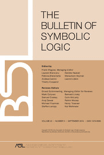
BULLETIN OF SYMBOLIC LOGIC
Transforming Ideas into Logical FrameworksBULLETIN OF SYMBOLIC LOGIC, published by Cambridge University Press, is a distinguished academic journal that serves as an essential platform for the dissemination of research in the realms of logic and philosophy. Since its inception in 1995, this journal has progressed through its convergence years and remains committed to fostering intellectual discourse among scholars. With a 2023 ranking in the Q1 category of Philosophy and a Q3 classification in Logic, it continues to uphold its reputation as a significant contributor to the field. While operating under a traditional subscription model, the journal dedicates itself to publishing high-quality articles that explore foundational issues, advanced theories, and innovative insights in symbolic logic. Researchers, professionals, and students will find invaluable resources within its pages, particularly as it ranks favorably among peers, with noteworthy standings in Scopus rankings. For those seeking to deepen their understanding of logical frameworks and their philosophical implications, BULLETIN OF SYMBOLIC LOGIC is an indispensable resource.
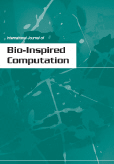
International Journal of Bio-Inspired Computation
Advancing the Frontiers of Bio-Inspired ComputingInternational Journal of Bio-Inspired Computation, published by INDERSCIENCE ENTERPRISES LTD, is a leading platform dedicated to advancing research in the fields of bio-inspired computing and its applications. With a robust ISSN of 1758-0366 and E-ISSN of 1758-0374, this journal contributes significantly to the discourse in Computer Science, particularly emphasizing theoretical and practical frameworks that mirror natural processes. Situated in Switzerland, this peer-reviewed journal operates under a rigorous editorial process, ensuring high-quality publications that attract considerable attention, as evidenced by its placement in the Q2 category for 2023 in General Computer Science and Q3 in Theoretical Computer Science. With Scopus rankings reflecting its growing influence—ranked #62 out of 232 in General Computer Science and #36 out of 130 in Theoretical Computer Science—this journal invites researchers, professionals, and students to explore innovative methodologies and development in bio-inspired technologies. Although it currently does not adopt an open-access model, the journal remains committed to disseminating vital research that fuels advancements in computational intelligence, fostering collaboration and knowledge exchange in the ever-evolving landscape of computing.
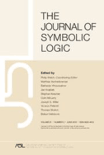
JOURNAL OF SYMBOLIC LOGIC
Advancing Knowledge in Symbolic LogicThe JOURNAL OF SYMBOLIC LOGIC, published by Cambridge University Press, stands as a leading platform for scholarly discourse in the realms of logic and philosophy. With a rich history dating back to 1938, this esteemed journal is dedicated to presenting cutting-edge research that pushes the boundaries of knowledge within symbolic logic and its applications. In 2023, it proudly holds a distinguished Q1 ranking in both Logic and Philosophy categories, reflecting its high impact and relevance in the academic community. Researchers and academics benefit from its rigorous peer-review process and contributions from leading scholars worldwide, ensuring the dissemination of high-quality research and critical theories. While the journal currently does not operate under an open access model, it remains a pivotal resource for professionals seeking to deepen their understanding of logical theories and philosophical inquiries. Explore the JOURNAL OF SYMBOLIC LOGIC to engage with scholarly articles that challenge conventional thought and inspire future research.

ALGORITHMICA
Elevating Algorithmic Insights for Tomorrow's ChallengesALGORITHMICA is a premier academic journal published by SPRINGER, dedicated to the field of algorithms and their applications across various domains. With an ISSN of 0178-4617 and an E-ISSN of 1432-0541, this journal serves as a vital resource for researchers and practitioners interested in the theoretical and practical aspects of algorithmic design and analysis. Recognized for its high impact, ALGORITHMICA is listed in the top quartile (Q1) for Applied Mathematics and Computer Science (miscellaneous) and is positioned in Q2 for Computer Science Applications in the 2023 category rankings. The journal has continuously contributed to advancing knowledge from its inception in 1986 to its ongoing publications through 2024. With a commitment to rigorous peer review and high-quality research, ALGORITHMICA is essential for anyone serious about pushing the boundaries of algorithmic study and application.
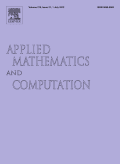
APPLIED MATHEMATICS AND COMPUTATION
Unveiling New Horizons in Applied MathematicsApplied Mathematics and Computation is a premier journal dedicated to the dissemination of high-quality research in the field of applied mathematics and computational methods. Published by Elsevier Science Inc, this influential journal has established itself as a key resource for researchers, professionals, and students interested in mathematical modeling, numerical analysis, computational algorithms, and their applications across various disciplines. With an impressive impact factor reflecting its scholarly credibility, it holds a distinguished position in the Q1 quartile for both applied and computational mathematics as of 2023, ranking #31/635 and #12/189 in Scopus categories respectively, thereby indicating its significant impact on the academic community. The journal encompasses a broad spectrum of topics, encouraging original research, critical reviews, and innovative methodologies that address real-world challenges. Although it currently does not offer open access options, it remains a cornerstone publication for those at the forefront of mathematical research, continuously bridging theory with practical computation since its inception in 1975.

JP Journal of Algebra Number Theory and Applications
Innovative Insights into Algebra and Number TheoryJP Journal of Algebra Number Theory and Applications is a distinguished publication within the field of mathematics, specifically focusing on algebra and number theory. Published by PUSHPA PUBLISHING HOUSE, this journal serves as a platform for researchers and professionals to disseminate their cutting-edge findings and innovative methodologies. With its ISSN 0972-5555, it caters to an audience eager to explore mathematical concepts and applications that impact various scientific domains. Although it operates on a subscription model, the journal's commitment to high-quality peer-reviewed content makes it a valuable resource for students and scholars alike. The journal offers an exclusive insight into the complex interplay between algebra and number theory, ensuring that it remains at the forefront of mathematical discourse despite its coverage discontinuation from Scopus. The absence of an H-Index and low rankings within Scopus underscore the challenges the journal faces in a competitive academic landscape; however, it continues to foster a community for the exchange of ideas and the advancement of knowledge in mathematics.

ACM Communications in Computer Algebra
Bridging Theory and Application in Computational ResearchACM Communications in Computer Algebra is an influential peer-reviewed journal published by the Association for Computing Machinery (ACM), dedicated to advancing the field of computer algebra. With its ISSN 1932-2232 and E-ISSN 1932-2240, the journal serves as a crucial platform for disseminating innovative research that intersects computational mathematics and theoretical computer science. As evidenced by its category quartiles, it holds a notable Q3 ranking in both Computational Mathematics and Computational Theory and Mathematics for the year 2023, reflecting its commitment to fostering rigorous scholarship. Although it remains a non-open access publication, the journal provides vital insights and findings that contribute significantly to the academic dialogue within these domains. Researchers, professionals, and students alike can rely on its curated content to stay abreast of advancements, applications, and methodologies pertinent to computer algebra, especially throughout its publishing epochs from 2011 to 2021, and resuming in 2023 through 2024.

BOLETIN DE LA SOCIEDAD MATEMATICA MEXICANA
Unveiling New Horizons in Mathematical ResearchBOLETIN DE LA SOCIEDAD MATEMATICA MEXICANA, published by Springer International Publishing AG, is a pivotal journal in the field of mathematics, particularly recognized for its contributions to the miscellaneous mathematics category, holding a commendable Q2 ranking as of 2023. With an ISSN of 1405-213X and an E-ISSN of 2296-4495, the journal serves as a platform for disseminating high-quality research and innovations from both national and international scholars. Operating from Switzerland, the journal encompasses a broad range of topics within mathematics, supporting the development and communication of mathematical knowledge. Although it is not open access, it remains a respected source for researchers, professionals, and students seeking to deepen their understanding of mathematical concepts and applications. Published continuously and rigorously since its converged years, BOLETIN DE LA SOCIEDAD MATEMATICA MEXICANA plays a crucial role in advancing mathematical discourse and collaboration across disciplines.